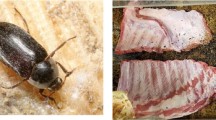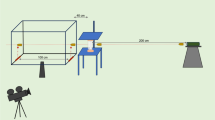Abstract
A range of investigative practices to aid explosive-related death investigations currently exist, although the use of histopathological bone samples to diagnose blast exposure and the distance of individuals from the blast source has not been previously reported. Forensic histopathology has been used effectively on soft tissue samples to define blast-related injuries effectively, analysing human organs such as the lungs, brain, liver, and skeletal muscles, providing important and useful forensic pathology interpretations. However, no studies currently exist examining the post-blast histological changes in human or animal bones subjected to blasts for forensic pathology practice, despite the opportunity that hard tissue bone samples present, given their significantly lower rate of decomposition over soft tissue. This study presents the first evidence-based findings on the post-blast histological changes in three animal bones when exposed to close-range chemical detonation (C4). The study’s qualitative findings highlight critical changes in the tissue architecture of three different animal bone sources due to blast effects with range from the blast source. This emphasises the potential use of histopathological bone sample analysis in future blast-related death investigations, while providing ideas to further explore this work using larger-scale experiments and post-blast case studies in aid of applying this work to human samples and forensic pathology practice.













Similar content being viewed by others
Data availability
Data sets generated during the current study are available from the corresponding author on reasonable request.
References
Blast Injury Research Coordinating Office (BIRCO) - The Science of Blast. https://blastinjuryresearch.health.mil/index.cfm/blast_injury_101/science_of_blast. Accessed 31 May 2024
Blast Injury Research Coordinating Office (BIRCO) - What is Blast Injury? https://blastinjuryresearch.health.mil/index.cfm/blast_injury_101/what_is_blast_injury. Accessed 31 May 2024
National Academies Press (US) (2014) Pathophysiology of blast injury and overview of experimental data. Gulf War Health, 9 - NCBI Bookshelf. https://www.ncbi.nlm.nih.gov/books/NBK202251/
Improvised Explosive Device Explosive Effects Mitigation - Center for Domestic Preparedness https://cdp.dhs.gov/training/course/AWR-337#:~:text=Blast%2C%20fragmentation%20and%20thermal%20effects,on%20both%20structures%20and%20personnel. Accessed 31 May 2024
Galante N, Franceschetti L, Del Sordo S et al (2021) Explosion-related deaths: an overview on forensic evaluation and implications. Forensic Sci Med Pathol 17:437–448. https://doi.org/10.1007/s12024-021-00383-z
Wolf SJ, Bebarta VS, Bonnett CJ et al (2009) Blast injuries. Lancet 374:405–415. https://doi.org/10.1016/s0140-6736(09)60257-9
Turillazzi E, Monaci F, Neri M et al (2010) Collection of trace evidence of explosive residues from the skin in a death due to a disguised letter bomb. The synergy between confocal laser scanning microscope and inductively coupled plasma atomic emission spectrometer analyses. Forensic Sci Int 197:e7–e12. https://doi.org/10.1016/j.forsciint.2009.12.012
Westrol MS, Donovan CM, Kapitanyan R (2017) Blast Physics and Pathophysiology of explosive injuries. Ann Emerg Med 69:S4–S9. https://doi.org/10.1016/j.annemergmed.2016.09.005
Hunold T, Wittschieber D, Ortmann C et al (2023) Blunt force trauma and blast injuries to head and chest caused by a potent pyrotechnic device: a case report. Int J Legal Med. https://doi.org/10.1007/s00414-022-02943-6
Siebke I, Abegg C, Fracasso T et al (2023) Awareness of forensic anthropology in Switzerland: a survey among forensic practitioners, police, and prosecutors. Int J Legal Med. https://doi.org/10.1007/s00414-023-03116-9
Tsokos M, Paulsen F, Petri S et al (2003) Histologic, immunohistochemical, and ultrastructural findings in human blast lung injury. Am J Respir Crit Care Med 168:549–555. https://doi.org/10.1164/rccm.200304-528oc
Pun PBL, Kan EM, Salim A et al (2011) Low level primary blast injury in rodent brain. Front Neurol 2. https://doi.org/10.3389/fneur.2011.00019
Sosa MaG, De Gasperi R, Paulino AJ et al (2013) Blast overpressure induces shear-related injuries in the brain of rats exposed to a mild traumatic brain injury. Acta Neuropathol Commun 1. https://doi.org/10.1186/2051-5960-1-51
Arun P, Oguntayo S, Alamneh Y et al (2012) Rapid Release of Tissue Enzymes into blood after blast exposure: potential use as Biological dosimeters. PLoS ONE 7:e33798. https://doi.org/10.1371/journal.pone.0033798
Greer N, Sayer NA, Kramer MHH, Koeller et al (2016) Prevalence and epidemiology of combat blast injuries from the military cohort 2001–2014. https://doi.org/10.13140/rg.2.1.3381.0327
Kalu DN, Hardin RR, Cockerham R (1984) Evaluation of the pathogenesis of skeletal changes in ovariectomized rats*. Endocrinology 115:507–512. https://doi.org/10.1210/endo-115-2-507
Newman E, Turner AS, Wark JD (1995) The potential of sheep for the study of osteopenia: current status and comparison with other animal models. Bone 16:S277–S284. https://doi.org/10.1016/s8756-3282(95)80121-9
Martin RK, Albright JP, Jee WSS et al (1981) Bone loss in the Beagle tibia: influence of age, weight, and sex. Calcif Tissue Int 33:233–238. https://doi.org/10.1007/bf02409442
Rodgers JB, Monier-Faugere M-C, Malluche H (1993) Animal models for the study of bone loss after cessation of ovarian function. Bone 14:369–377. https://doi.org/10.1016/8756-3282(93)90166-8
Weiss A, Arbell I, Steinhagen-Thiessen E, Silbermann M (1991) Structural changes in aging bone: Osteopenia in the proximal femurs of female mice. Bone 12:165–172. https://doi.org/10.1016/8756-3282(91)90039-l
Miller SC, Bowman BM, Jee WSS (1995) Available animal models of osteopenia — small and large. Bone 17:S117–S123. https://doi.org/10.1016/8756-3282(95)00284-k
Grynpas MD, Huckell CB, Reichs KJ et al (1993) Effect of age and osteoarthritis on bone mineral in rhesus monkey vertebrae. J Bone Miner Res 8:909–917. https://doi.org/10.1002/jbmr.5650080803
Ferguson D, Davis WL, Urist MR et al (1987) Bovine bone morphogenetic protein (bBMP) fraction-induced repair of craniotomy defects in the Rhesus Monkey (Macaca Speciosa). Clin Orthop Relat Res 219:251–258. https://doi.org/10.1097/00003086-198706000-00035
Riond J-l, Kocabagli N, Spichiger UE, Wanner M (1995) Postparturient hypocalcemia of dairy cows: a model for the study of the interdependence of CA, Pi, and MG homeostasis. Bone 17:S429–S434. https://doi.org/10.1016/8756-3282(95)00322-5
Ferretti JL, Vázquez SO, Delgado CJ et al (1992) Biphasic dose-response curves of cortisol effects on rat diaphyseal bone biomechanics. Calcif Tissue Int 50:49–54. https://doi.org/10.1007/bf00297297
Aerssens J, Van Audekercke R, Talalaj M et al (1994) Effect of 1α-vitamin D3 on bone strength and composition in growing rats with and without corticosteroid treatment. Calcif Tissue Int 55:443–450. https://doi.org/10.1007/bf00298558
Aerssens J, Van Audekercke R, Geusens P et al (1993) Mechanical properties, bone mineral content, and bone composition (collagen, osteocalcin, IGF-I) of the rat femur: influence of ovariectomy and nandrolone decanoate (anabolic steroid) treatment. Calcif Tissue Int 53:269–277. https://doi.org/10.1007/bf01320913
Aerssens J, Boonen S, Lowet G, Dequeker J (1998) Interspecies Differences in bone composition, density, and quality: potential implications for in vivo bone research*. Endocrinology 139:663–670. https://doi.org/10.1210/endo.139.2.5751
Klatt ECMD Histotechniques. In: Edward C. Klatt MD. https://webpath.med.utah.edu/HISTHTML/HISTOTCH/HISTOTCH.html. Accessed 31 May 2024
Nishshanka LCB, Shepherd C, Ariyarathna MR et al (2021) An android-based field investigation tool to estimate the potential trajectories of perforated AK bullets in 1 mm sheet metal surfaces. Forensic Sci Int Digit Invest 38:301267. https://doi.org/10.1016/j.fsidi.2021.301267
Nishshanka B, Shepherd C, Ariyarathna R (2020) A software based solution to estimate the angles of incidence of AK bullets using bullet hole features on 1 mm sheet metal. KDU. http://ir.kdu.ac.lk/bitstream/handle/345/2937/FOC%20107-113.pdf?sequence=1&isAllowed=y
Nishshanka B, Shepherd C, Ariyarathna R (2022) A forensic-related study on AK bullet (7,62 x 39 mm) holes on 1 mm sheet metal and the designing of the first android-based field investigation tool for AK gun-related bullet trajectory reconstruction. 74th Annual Meeting, AAFS, Seattle, Washington, USA
Florencio-Silva R, Da Silva Sasso GR, Sasso-Cerri E et al (2015) Biology of bone tissue: structure, function, and factors that influence bone cells. Biomed Res Int 2015:1–17. https://doi.org/10.1155/2015/421746
Zhao W, Byrne MH, Wang Y, Krane SM (2000) Osteocyte and osteoblast apoptosis and excessive bone deposition accompany failure of collagenase cleavage of collagen. J Clin Investigation/The J Clin Invest 106:941–949. https://doi.org/10.1172/jci10158
Plotkin LI (2014) Apoptotic osteocytes and the control of targeted bone resorption. Curr Osteoporos Rep 12:121–126. https://doi.org/10.1007/s11914-014-0194-3
NCI Dictionary of Cancer Terms In: Cancer.gov. https://www.cancer.gov/publications/dictionaries/cancer-terms/def/bone-marrow. Accessed 31 May 2024
Professional CCM Coagulative necrosis. In: Cleveland Clinic. https://my.clevelandclinic.org/health/diseases/24191-coagulative-necrosis. Accessed 31 May 2024
Partridge R (2016) Explosions. In: Elsevier eBooks. pp 821–824. https://doi.org/10.1016/b978-0-323-28665-7.00163-1
Naeim F, Rao PN, Song SX, Grody WW (2013) Morphology of abnormal bone marrow. In: Elsevier eBooks. pp 69–79. https://doi.org/10.1016/b978-0-12-385183-3.00005-x
Ramasamy A, Hughes A, Carter N, Kendrew J (2013) The effects of explosion on the musculoskeletal system. Trauma 15:128–139. https://doi.org/10.1177/1460408613484683
Ramasamy A, Hill AM, Masouros S et al (2010) Blast-related fracture patterns: a forensic biomechanical approach. J Royal Soc Interface 8:689–698. https://doi.org/10.1098/rsif.2010.0476
Comparison between human and non-human skeletal remains – Forensic anthropology. https://ebooks.inflibnet.ac.in/antp07/chapter/158/#:~:text=Animal%20bones%20have%20a%20greater,in%20animal%20proximal%20limb%20bones. Accessed 31 May 2024
Funding
This study was funded by Centre for Defence Research and Development, MOD, Sri Lanka – Grant no: RC 39 (2023)
Author information
Authors and Affiliations
Contributions
Bandula Nishshanka: Conceptualization, Methodology, Validation, Formal Analysis, Data curation, Investigation, Resources, Writing- Original draft preparation, Visualization, Investigation. Iranthi Kumarasinghe Formal Analysis, Data curation, Investigation, Resources, Investigation. Chris Shepherd: Conceptualization, Methodology, Validation, Formal Analysis, Data curation, Investigation. Paranitharan Pirunubarasingham Conceptualization, Methodology, Validation, Formal Analysis, Data curation, Investigation, Visualization, Investigation. Damith Mohotti : Supervision, Writing- Reviewing and Editing Randika Ariyarathna : Conceptualization, Methodology, Validation, Formal Analysis, Data curation, Investigation, Resources, Writing- Original draft preparation, Visualization, Investigation.
Corresponding author
Ethics declarations
Ethical approval
Not applicable.
Consent participants
Not applicable.
Competing interests
The authors declare that they have no known competing financial interests or personal relationships that could have appeared to influence the work reported in this paper.
Additional information
Publisher’s Note
Springer Nature remains neutral with regard to jurisdictional claims in published maps and institutional affiliations.
Rights and permissions
Springer Nature or its licensor (e.g. a society or other partner) holds exclusive rights to this article under a publishing agreement with the author(s) or other rightsholder(s); author self-archiving of the accepted manuscript version of this article is solely governed by the terms of such publishing agreement and applicable law.
About this article
Cite this article
Nishshanka, B., Kumarasinghe, I., Shepherd, C. et al. Post-blast histological changes to three animal bones exposed to close-range chemical detonation. Int J Legal Med (2024). https://doi.org/10.1007/s00414-024-03270-8
Received:
Accepted:
Published:
DOI: https://doi.org/10.1007/s00414-024-03270-8




